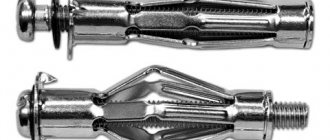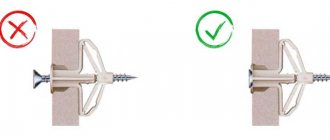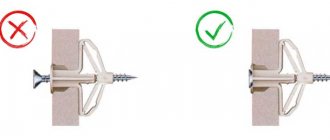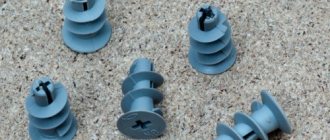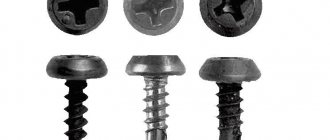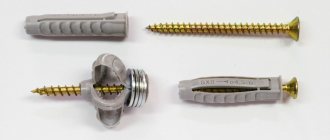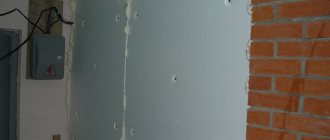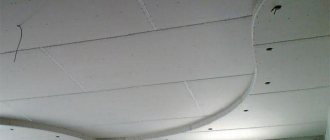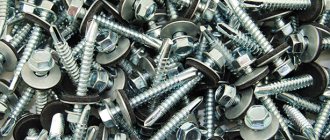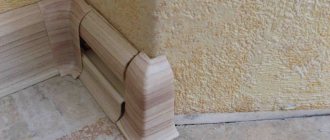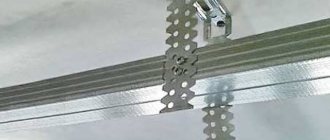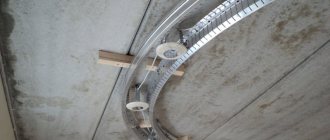Drywall is good because it allows you to quickly and efficiently level walls or ceilings. But the material has one significant drawback: it is fragile and is not designed for the load of a wall cabinet or shelf. Traditional fastening methods in the case of gypsum plasterboard surfaces are unreliable: the material begins to crumble. In such a situation, a fundamentally different fastener is used - a special dowel for drywall.
Advantages and disadvantages of Molly dowel
When fixed into a hole, the dowel is installed closed. Only when the screw is screwed in does the shape of the Molly dowel change, which is a conical or umbrella type support. It fits tightly in the hole. The screw itself is installed a little differently when compared to conventional dowels. It doesn't need to be screwed in. The screw is pulled out with a special tool. Use pliers to get the fastener in working order. This type of installation allows you to reuse the Molly dowel. If desired, you can easily remove it from the hole without losing the properties of the hardware.
Molly dowels are exclusively metal fasteners, which are mainly made of steel. Additional treatment in the form of galvanization provides anti-corrosion protection. If maximum protection is needed for serious projects, stainless steel dowels can be used. This is due to the high cost of the products.
According to experts, the main disadvantage of Molly dowels is the required free space. The fastener cannot be installed in a confined area. The pliers for installation and the hardware itself have certain parameters that require space.
Other varieties
To attach the chandelier, it is best to use spring-type fasteners. In addition to the spring mechanism, the drywall dowel umbrella uses folding wings and a special metal rod, which powers these wings. Such a dowel is inserted into the hole with pressed petals, which the spring will unfold as soon as the fastener reaches the empty body.
The umbrella dowel has folding wings that open after screwing
Chemical anchors are a special capsule containing an adhesive mixture. The capsule will be crushed and the glue will leak out at a certain moment when such an anchor is attached. A special chemical reaction inside the hole creates a bond that will provide a secure fit.
Choosing Molly dowels: what to look for
When choosing fasteners, you need to take into account a number of characteristics and parameters of the Molly dowel. List of mandatory characteristics that are important to evaluate:
- hardware diameter: determined by the load that the Molly dowel must withstand. The increased diameter determines high load-bearing capacity;
- dowel length: for fixation and reliable connection with a dowel, you need to estimate the size of the spacer part, due to which the friction force will be created. If the length of the non-expanding part exceeds the thickness of the material layer, it will be impossible to guarantee reliable fastening;
- material: stainless steel is considered the most durable and resistant to external factors (water, dampness, chemical fumes).
When choosing a fastener, it is also important to obtain information from the labeling. Each standard defines its own values, indicated by markings. These can be the following parameters: thread diameter, length, screw type, base thickness and others.
Dimensions
When choosing a molly, it is extremely important to pay attention to its size. This parameter must be taken into account, because it will determine how firmly the dowel will settle in the gypsum board sheet. You need to choose the appropriate size taking into account the thickness of the drywall sheet. The same point must be taken into account when choosing a roofing screw for wood.
Table 1 - Dimensions
| 4 x 21 | 6 |
| 4 x 32 | 7,18 |
| 4 x 38 | 8,5 |
| 4 x 46 | 9,4 |
| 4 x 54 | 9,5 |
| 4 x 59 | 10,9 |
| 5 x 37 | 11,8 |
| 5 x 52 | 15,5 |
| 5 x 65 | 19,7 |
| 5 x 80 | 23,6 |
| 6 x 37 | 15,6 |
| 6 x 52 | 20,8 |
| 6 x 65 | 26,4 |
Types of Molly dowels for drywall
Molly dowels are special fasteners, so there are not many varieties of them. The dowels differ from each other in the material they are made from. Fasteners made of galvanized steel have a galvanic coating, while fasteners made of stainless steel have an anti-corrosion coating. The second option is considered more resistant to temperature changes, moisture, and water. Stainless steel hardware costs an order of magnitude more, but justifies the price with its performance properties.
In terms of design features, the dowels themselves are virtually no different. Only the types of screws used to secure them are distinguished. The following modifications are found:
- countersunk head - the head has a flattened shape, which is installed flush with the material or “recessed”. Due to the flat shape of the cap, it is difficult to dismantle it, so damage to the drywall itself is possible;
- semicircular head – remains on the surface, does not hide. Dismantling is easier;
- screw with hook - used for installing suspended objects and structures. Great for attaching to plasterboard ceilings;
- screw with a ring - for solving issues of installation of communications, non-standard objects of complex configuration.
How to properly attach Molly dowels?
To work with Molly dowels you need to follow certain rules. To install the fastener in plasterboard material, you will need to tighten the screw twice. If you are fastening suspended structures, then the screw is installed in one go.
Molly dowels are most often used for fastening structures and interior items, rather than other materials. To correctly calculate hardware parameters and consumption, it is important to calculate the load that the fastener will withstand. If you are attaching a dowel to a plasterboard wall, its working load will be from 12 kg. In order not to make a mistake with the length of the dowel, it is important to take into account the following factors when making calculations: surface thickness and thickness of the structure. After summing up these indicators, fasteners are selected. The resulting figure must match the size of the non-expanding part of the hardware.
To quickly create a connection, you will need special pliers. This is a tool with a slot that perfectly grips the surface between the washer and the head. The dowel is pulled out during installation. If you don’t have such pliers in your arsenal, you can try to solve the problem using pliers. The process will take longer and requires some effort.
Basic algorithm for installing a Molly dowel:
- A hole of the required diameter is made in the drywall using a drill. The resulting hole should match the diameter of the Molly dowel.
- The collet is fixed to the maximum depth so that it rests against the base of the drywall. If difficulties arise, use a hammer with a rubber working surface.
- Then you can proceed to screwing in the fasteners. The easiest way to screw in a screw is with a screwdriver or screwdriver. Even after this, Molly's dowel remains in the same position.
- We take pliers and pull out the screw. The collet is folded.
- We continue to pull out the screw, after which we fasten it a second time, grabbing the structure that needs to be fastened. If you need to install hanging items, the screw is simply screwed in again.
Drywall fasteners: is it possible to replace the Molly dowel?
There are other types of fasteners that can be used to secure structures to drywall. The Molly dowel is considered the most convenient and widespread hardware. But does he have an alternative?
Plastic dowels are made from durable materials that have proven themselves in the market. At the end of the plastic dowel there is a drill, due to which it is screwed into the drywall independently. You don't have to make a pilot hole to attach the dowel. The final step will be screwing in the screw. It will fix the fastener in the hole and provide good load-bearing capacity.
Metal Molly dowels work on the same principle as their plastic counterparts. The main advantage will be the material of manufacture. High-strength steel can withstand more loads and demonstrates excellent performance properties.
When working with drywall, the Molly dowel remains the most durable and effective fastener. Even taking into account its increased cost, fasteners remain most in demand when attached to drywall.
Fischer P.D.
One of the newest and most convenient developments in the field of drywall fasteners. The principle of operation is original in that when the self-tapping screw is screwed into the dowel, its conical shank is pressed into the plastic sleeve, forcing the stop wings to open. When the sheet thickness is small, they apply pressure from the back side. If the thickness of the drywall is significant, they will jam the dowel in the drilled hole.
Such fasteners can withstand 12–15 kg. Installing it is simple:
- Preparing a hole in the drywall.
- The dowel is inserted. Longitudinal ribs will prevent it from turning, and a reinforced flange will prevent it from falling into the hole.
- The locking screw is tightened. As it moves, the “wings” open and the dowel is fixed.
What types of fasteners are used for drywall?
For plasterboard bases, other dowels are also used, which are designed for fastening to porous materials. Let's look at the main types of fasteners:
- “butterfly”: can withstand up to 30 kg of load. This type of fastener is suitable for installing various interior items, lamps, electrical wiring and other light objects. Due to the presence of protruding elements that form a kind of “skirt,” wings are formed when the fasteners are tightened. To install into the hole in the dowel, you need to clamp the tabs. The notches are held in the plasterboard base to prevent any unwinding. The “wings” are adjacent to the material. The main advantages of the butterfly dowel are the possibility of reusable use and easy installation;
- “umbrella”: the design of this type of dowel provides for the presence of two folding elements on springs, which are at an angle of about 180 degrees. This dowel is designed for fixing objects in hollow bases. This is the best mounting option if you need to hang the lamp from the ceiling. To install the dowel, clamp the folding “legs” and place it in the hole. After this, the dowel opens in the shape of an umbrella. The fastener may have a hook or ring, from which structures can be conveniently suspended;
- dowel-nail: consists of two parts - a plastic element and a metal screw. After installing the dowel-nail, it will be almost impossible to dismantle the plastic part, but the screw itself can be unscrewed with a screwdriver. The dowel-nail is fixed with a hammer. With the help of such fastening a small weight is fixed;
- Driva: has a conical shape with a flat head. The tip is made in an acute-angled shape. The screw that is screwed into the dowel can be through or blind. This fastener can be used independently without pre-drilling holes. Even with a simple screwdriver you can easily screw the dowel into the drywall. During the process of fastening the screw, one part of the dowel is deformed. Due to its expansion, the hardware will not be able to unwind arbitrarily. This type of dowel is good because it can be fixed in drywall even with a minimum distance between the gypsum board and the support. Driva clamps are reused after dismantling;
- The Fischer dowel has a self-tapping thread, so it easily passes through drywall. The dowel expands when the screw is installed, and the thread itself is fixed in the material. Due to the design features of the modern dowel, the connection does not weaken over time;
- ceiling dowels for plasterboard and hollow materials. The design of the dowels has spring parts with which they are fixed to the sheets, holding them on the back side of the material. There is an abundance of caps and hooks that distinguish fasteners from each other;
- Sormat is available in two materials – nylon and metal. Only light objects can be attached to drywall with such a dowel. The tip of the dowel has a threaded part with protruding teeth. This allows it to easily pass through the drywall base without a pilot hole. Simple installation is facilitated by a 5 mm pitch between threads. When working with Sormat, there is minimal risk of sheet deformation or weakening of the connection;
- NAT is a nylon dowel whose clamps resemble “wings.” They are held by the base from the wrong side. With permissible loads on the fastener, it cannot be pulled out or loosened. The hole itself does not loosen.
"Har
Champion among fasteners in terms of weight held. Capable of withstanding loads up to 55 kg. It consists of a metal U-shaped bar with locking bushings and two plastic guides.
Installation diagram:
- A hole with a diameter of 13 mm is drilled in the drywall.
- A metal strip is inserted into it. By pulling the guides and aligning them relative to each other, it must be brought into working position.
- The guides are inserted into a clear plastic sleeve. It is inserted into the hole until it stops.
- The ends of the guides move in different directions and then break off.
- The screw included in the delivery set is screwed into the dowel.
Installation of Hartmut fasteners: step 1
Step 2
Step 3
Step 4
Step 5
Step 6
Rear view
The result is a very reliable fulcrum that can withstand heavy loads.
When can you not do without a Molly dowel?
All-metal fasteners are suitable not only for fastening into drywall, but also into hollow walls or sheet materials. The opening mechanism on the back side of the hardware provides better fastening strength. The load-bearing load is determined not only by the parameters of the dowel itself, but also by the characteristics of the base material. The Molly dowel is perfect for sheets up to 26mm thick. If the wall is insulated and you used insulating material when installing it, difficulties may arise when installing the dowel.
Molly dowels, the elements of which are made exclusively of durable steel, are indispensable for installation in fire hazardous areas. Once installed, you can dismantle and even reuse the hardware. Galvanized dowels are intended for rooms without exposure to moisture, precipitation, or temporary connections. Stainless steel products are considered the most resistant to external factors.
